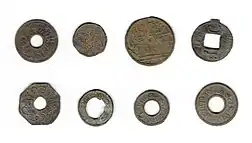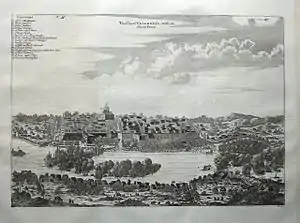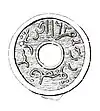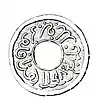Palembang pitis
The Palembang pitis (also spelled pitjis) was a currency issued by the Palembang Sultanate from the 1600s until 1825 when the sultanate was dissolved and its territory taken over by the colonial government of the Dutch East Indies.[1] The currency consisted of low denomination tin alloy coins which were mostly traded in bulk. Due to the lack of a centralized mint, the pitis often had inconsistent manufacture and were frequently counterfeited.
| ڤيتس ڤلمبڠ | |
|---|---|
 Some coins of Palembang pitis | |
| Denominations | |
| Superunit | |
| 250 | kupat |
| 500 | cucuk |
| Demographics | |
| Date of introduction | 1600s |
| Date of withdrawal | 1825 |
| User(s) | Palembang Sultanate |
History

Palembang, like Banten, had become an independent sultanate when Demak Sultanate declined following the death of Sultan Trenggana in 1546. Thereafter from the 1560s to 1620s, Palembang became an active trade participant in two key products of the region, pepper and tin.[2] During the course of this trade, coins from various local sultanates circulated in Palembang, namely Banten, Siak, Kampar and Jambi, in addition to Chinese cash coins which had already been circulating in the archipelago. Palembang's earliest coinage date from this period, which were tin imitation of Chinese cash with Chinese characters phonetically rendering "pangeran" or "sultan" into panglân (邦闌)[3][4][lower-alpha 1] and sútan (史丹) respectively, dated between 1600 and 1658.[4][5][6] This was followed by an issue with Arabic Jawi inscription reading 'alamat sulṭan (علامت سلطان), dated between 1658 and 1710.[7] The second half of the 17th century saw increasing monopoly of Dutch East Indies Company (VOC) in the pepper and tin trade. This severely undermined the regional trading network and undermined the prosperity of local sultanates. Local coins became scarce in Palembang, with the exception of coins minted at Palembang itself.[8] Beside the pitis, the early 1700s also saw the release of VOC duiten and Spanish dollar, which also circulated in Palembang.[9][10]
Around 1710, tin deposits were discovered on Bangka Island, which was part of Palembang Sultanate at the time.[11][12] The discovery led to a tin surplus which was traded in form of ingots by the sultanate and provided materials for low denomination coinage in mass quantity. The eighteenth century coinage of Palembang Sultanate consisted of two separate coin series. The first is the sultan's small-size coins bearing Jawi inscriptions,[13] and the second is larger-size coins bearing Chinese inscription.[14] The Chinese style coins, which were minted for the Chinese mining communities on Bangka are commonly thought to only circulate in Bangka. However, Bangka at the time had close ties with the administration of Palembang City and Chinese style coins appear to have also been minted in the city as well. It is very likely that the Chinese style coins circulated side by side with the sultan's coins within the core areas of Palembang.[10]
In 1812, Palembang lost its source of tin when British forces occupied Bangka Island. The island went on to become a nominal Dutch possession after the Anglo-Dutch Treaty of 1814 and was formally handed over to the Dutch in 1816.[15] Around 1820s, Sultan Mahmud Badaruddin II rose up against the Dutch and was defeated by the Dutch general Hendrik Merkus de Kock in 1821. The Dutch divested Mahmud of his powers and exiled him to Ternate in the same year. In 1825, the Dutch took Palembang under direct Dutch administration. The last dated Palembang pitis was from 1804, and presumably further production ceased by 1825.[16][17]
Manufacture
Palembang's output of coins had been fairly restrained before 1710, but tin surplus expanded the state's coinage. Pitis were cast in the same way as Chinese cash coins: molten tin was first cast into molds which resulted in "coin trees." Individual coins were then broken off and polished to round the edges, although stem remnants from unthorough polishing are commonly seen in Palembang pitis. Finally, a die is used to struck the coin with the appropriate inscription.[18][19]
Official coinage issued by the Sultan formed only one part of the total coinage circulating in Palembang, as the manufacture of counterfeit coinage became a major industry. Counterfeit coins could have been made by almost anyone with access to Palembang's tin supply during the period of tin surplus. There are reports of severe punishment against counterfeiters,[20] but as the quality of official pitis themselves were often inconsistent due to lack of centralized manufacture, it may be difficult to ascertain whether a particular sample is official or unauthorized issue.[21][19] Common inconsistencies include size, weight, and inscriptions (which were especially prone of deformation in early types).
Types
All currency of Palembang pitis consisted of coins made from tin-lead alloy, except for a single copper issue. Each type contain inscription on the obverse with blank reverse. Most contain the Arabic phrase في بلد ڤلمبڠ fi bilad Palembang ("in the land of Palembang") rendered in Jawi script, and some included year of mintage using Hijri era or Anno Hegirae (AH). Coins could be divided into two categories: coins without a hole called pitis buntu and coins with a hole called pitis teboh,[22] which included Chinese cash imitations. Disregarding variants, some of the known types produced by the official Palembang mint are as following:[23][24][13][25][26]
Pitis Buntu
| Inscription | Year of mintage | Image | Reigning Sultan | ||
|---|---|---|---|---|---|
| Jawi | Romanization | AH | CE | ||
| ڤلمبڠ ? | ? Palembang[lower-alpha 2] | – | (circa 1750[lower-alpha 3] or 1812–1816[lower-alpha 4]) | _01.jpg.webp) |
|
| ال سلطان في بلد ڤلمبڠ ١١٩٣ | al-Sulṭan fi bilad Palembang sanat 1193 | 1193 | 1779/80 | _02.jpg.webp) | Muhammad Bahauddin (1776–1803) |
Pitis Teboh
| Inscription | Year of mintage | Image | Reigning Sultan | ||
|---|---|---|---|---|---|
| Jawi | Romanization | AH | CE | ||
| 邦闌㒷宝 | bānglán xīngbǎo (Mandarin)[lower-alpha 5] panglân hengpó (Hokkien) | – | (circa 1600–1658) |  |
|
| 史丹利寶 | shǐdān lìbǎo (Mandarin)[lower-alpha 6] sútan līpó (Hokkien) | – | (circa 1600–1658) |  |
|
| علامت سلطان | 'alamat Sulṭan[lower-alpha 7] | – | (circa 1658–1710) | .jpg.webp) |
|
| ضرب في بلد ڤلمبڠ دار السلام | ḍarb fi bilad Palembang dar al-salam | – | (circa 1710–1778) | _01.jpg.webp) |
|
| علامت في بلد ڤلمبڠ دار السلام ١١٦٢ | 'alamat fi bilad Palembang dar al-salam sanat 1162 | 1162 | 1749/50 |  | Mahmud Badaruddin I Jayo Wikramo (1724–1757) |
| هذا فلوس في بلد ڤلمبڠ ١١٩٨ | hadha fulus fi bilad Palembang sanat 1198[lower-alpha 8] | 1198 | 1783/84 |  | Muhammad Bahauddin (1776–1803) |
| ال سلطان في بلد ڤلمبڠ | al-Sulṭan fi bilad Palembang sanat (date) | 1200–1204 | 1785–1789/90 | .jpg.webp) | Muhammad Bahauddin (1776–1803) |
| مصروف في بلد ڤلمبڠ ١٢١٩ | maṣruf fi bilad Palembang 1219 | 1219 | 1804/5 | .jpg.webp) | Mahmud Badaruddin II (1804–1813, 1818–1821) |
Exchange Rate
Palembang pitis served as low denomination currency valued and exchanged in bulks with the VOC duiten and Spanish dollar. Buntu and teboh were worth the same and they only differed in their group units. Pitis buntu were grouped into parcels wrapped in leaves. A parcel with 250 pieces is known as a kupat (كوفات) which has the value of one kejer equivalent to 20 duiten and 1⁄16 dollar. Pitis teboh were grouped into strings with a piece of rattan or twine, similar to Chinese cash. A string with 500 pieces is known as cucuk (چوچق) which has the value of one tali equivalent to two kejer. Known units of value and their exchange rate are shown below.[22][30]
| Palembang pitis | VOC duiten | Spanish dollar | |||
|---|---|---|---|---|---|
| Unit | Equivalence | # pieces | |||
| ريال | real | 2 jampel | 4000 | 320 | 1 |
| جمفل | jampel | 2 suku | 2000 | 160 | 1⁄2 |
| سوكو | suku | 2 tali | 1000 | 80 | 1⁄4 |
| تالي | tali | 2 kejer | 500 | 40 | 1⁄8 |
| كجر | kejer | (1 kupat or 1⁄2 cucuk) | 250 | 20 | 1⁄16 |
| - | - | (1⁄2 kupat or 1⁄4 cucuk) | 125 | 10 | 1⁄32 |
Notes
- Mitchiner (2012:35-36) identified the characters for "pangeran" as 邦㒷 and annotate them as pang lan. However, this seems to be a mistranscription, as the character 㒷 (a simplified variant of 興) is not known to have pronunciation similar to lan in any varieties of Chinese.
- The stylized lettering of this coin is difficult to read. The few writers who have reviewed this coin only agreed on the "Palembang" part.[27][28]
- According to Robinson (2015).
- According to Mitchiner & Yih (2013:43)
- Mitchiner (2012:35) noted that some source attributed this coin to Cirebon, such as Millies (1871:53-54, Plate XV), but recent evidence suggests Palembang as the more likely issuer.
- Idem
- Mitchiner (2012:36) noted that some source attributed this coin to Jambi, such as Millies (1871:109), but recent evidence suggests Palembang as the more likely issuer.
- This is the only known type to have a copper issue.[29]
References
- Hall 1968, pp. 576.
- Hall 1968, pp. 277–279.
- Hartill 2017, pp. 174.
- Millies 1871, pp. 54.
- Mitchiner 2012, pp. 35–36.
- Yih 2010, pp. 27–31.
- Yih 2011.
- Mitchiner & Yih 2013a, pp. 31–32.
- Bucknill 1931, p. 15.
- Mitchiner & Yih 2013a, pp. 32.
- Millies 1871, pp. 117.
- Wicks 1983, pp. 287–288.
- Mitchiner & Yih 2013a, pp. 33–43.
- Mitchiner & Yih 2013b, pp. 29.
- Hall 1968, pp. 543, 576.
- Mitchiner & Yih 2013a, pp. 32–33.
- Mitchiner 1968, pp. 543, 576.
- Mitchiner & Yih 2013a, pp. 32, 35.
- Robinson 2018, pp. 1.
- Millies 1871, pp. 110.
- Mitchiner & Yih 2013a, pp. 34, 35, 39.
- Netscher & Chijs 1855, pp. 169.
- Netscher & Chijs 1855, pp. 167–170.
- Millies 1871, pp. 111–116.
- Robinson 2015.
- Gumilar 2021, p. 8-9.
- Millies 1871, pp. 114.
- Mitchiner & Yih 2013a, pp. 43.
- Mitchiner & Yih 2013a, pp. 39.
- Millies 1871, pp. 115–116.
Bibliography
- Aelst, Arjan van (1995). "Majapahit Picis: The Currency of a "Moneyless" Society 1300-1700". Bijdragen tot de Taal-, Land- en Volkenkunde. 151 (3): 357–393. doi:10.1163/22134379-90003037. JSTOR 27864677.
- Bucknill, John A. S. (1931). The Coins of the Dutch East Indies: An Introduction to the Study of the Series. Asian Educational Services. ISBN 8120614488.
- Gumilar, Agung (2021). "Use of Malay-Arabic Scriptures of Jawi/Pegon in Number of Ancient Metal Currencies in Indonesia from Pre-Independence to Early Independence". Al-Urwatul Wutsqo: Jurnal Ilmu Keislaman Dan Pendidikan (in Indonesian). 2 (1). ISSN 2747-0105.
- Hall, D. G. E. (1968). A history of South-east Asia, 3rd edition. ISBN 9781349165216.
- Hartill, David (2017). A Guide to Cash Coins. New Generation Pub. ISBN 978-1787192997.
- Millies, Henricus Christiaan (1871). Recherches sur les monnaies des indigènes de l'archipel Indien et de la pèninsule Malaie (PDF) (in French). La Haye: M. Nijhoff.
- Mitchiner, Michael (2012). "Coin Circulation in Palembang (Sumatra), circa AD 1710 to 1825. Including Coins made in Banten, Siak, Kampar, Indragiri, Jambi, Palembang and Batavia" (PDF). Journal of the Oriental Numismatic Society. 213: 22–38. ISSN 1818-1252.
- Mitchiner, Michael; Yih, Tjong Ding (2013a). "Coin Circulation in Palembang (Sumatra), circa AD 1710 to 1825. Sultanate coins minted at Palembang" (PDF). Journal of the Oriental Numismatic Society. 215: 30–43. ISSN 1818-1252.
- Mitchiner, Michael; Yih, Tjong Ding (2013b). "Coin Circulation in Palembang (Sumatra), circa AD 1710 to 1825. Coins Minted for the Mining Communities on Bangka Island" (PDF). Journal of the Oriental Numismatic Society. 217: 27–46. ISSN 1818-1252.
- Netscher, Elisa; Chijs, Jacobus Anna (1855). De munten van Nederlandsch Indië, beschreven en afgebeeld (in Dutch). Lange. pp. 167–170, plate XXIII.
- Robinson, Frank S. (2015). Palembang Coins. Verity Press International. OCLC 925366115.
- Wicks, Robert S. (1983). A Survey of Native Southeast Asian Coinage Circa 450-1850: Documentation and Typology. Cornell University. OCLC 220653588. ProQuest 303266404.
- Yih, Tjong Ding (2010). "Tiny pitis inscribed "Shi-Dan" (Sultan) from Palembang" (PDF). Journal of the Oriental Numismatic Society. 204: 27–31. ISSN 1818-1252.
- Yih, Tjong Ding (2011). "Palembang picis inscribed 'Alamat Sultan'" (PDF). Journal of the Oriental Numismatic Society. 209: 32–35. ISSN 1818-1252.
.jpg.webp)